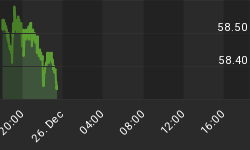In the article "Bull Factor: Reversal Of Price Failures", I spoke of key levels where buying and selling would most likely take place. A key support level is a pivot point low occurring at a time when investor sentiment is bearish (i.e, bull signal). Over 40 years of back testing suggests the following with regards to these key support levels: 1) these areas are good low risk buy points; 2) breaks of these key levels can lead to accelerated price moves lower; and 3) reversals of these breakdowns typically lead to moves higher. These key areas are shown with the red dots in figure 1, a weekly chart of the ETF proxy for the S&P500, the S&P Deposit Receipts (symbol: SPY).
Figure 1. SPY/ weekly
Last week's key buying level for the SPY was 86.78. As long as the SPY held above 86.78 on a weekly closing basis, then the rally, which started two weeks ago, was sustainable. Friday afternoon's rally brought the SPY back above this key level. I would become suspicious of this rally if this level (86.78) did not hold on a weekly closing basis.
Now let's stay with figure 1, and focus on the price bars with the red labeling. These are positive divergence bars between a momentum oscillator and price. Positive divergence bars tend to occur at market bottoms and are of indicative of decreasing downside price momentum. They don't always lead to trend reversals, and more likely the highs and lows of the divergence bar will define a price range. A weekly close above the highs of the positive divergence bar will lead to higher prices (and is considered a breakout) and a weekly close below the lows of the positive divergence bar will lead to lower prices (and is considered a breakdown). The highs of the current positive divergence bar are at 90.13.
My interpretation of the SPY chart is as follows: the price action has been good with a weekly close over 86.78. Currently, prices are trading to resistance levels as defined by the highs of the positive divergence bar. A weekly close below 81.78 would be serious technical damage. A weekly close below 86.78 implies weakness and increasing caution.
Figure 2 is a weekly chart of the Dow Jones Industrials ETF proxy, the Diamond Trusts (symbol: DIA). The key levels and positive divergence bars are noted.
Figure 2. DIA/ weekly
Figure 3 is a weekly chart of the Power Shares QQQQ Trust (symbol: QQQQ); prices are currently probing the upper reaches of the resistance zone as determined by the key support level at 29.72 and the highs of the positive divergence bar at 29.35. A weekly close over these levels would be very bullish and likely catapult the markets into a mutli week rally. For now and until further notice, the current price action in the QQQQ is suggestive of a bear market rally into resistance.
Figure 3. QQQQ/ weekly
Figure 4 is a weekly chart of the i-Shares Russell 2000 Index (symbol: IWM). Resistance levels are noted and like the QQQQ, this is nothing more than a bear market rally unless these levels are taken out on a weekly closing basis.
Figure 4. IWM/ weekly
The major indices and their ETF proxies are providing a mixed picture. The SPY and DIA appear to be further along in the bottoming process as key resistance levels have been taken out already. The QQQQ and IWM have traded back to prior areas where selling commenced and old breakdown areas (or resistance levels) have not been convincingly taken out.















